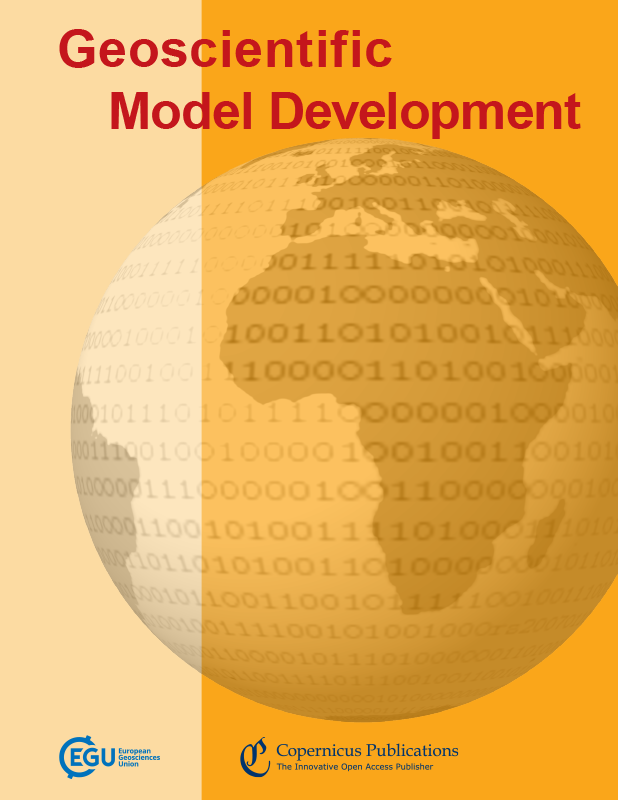一个全耦合的三维冰川均衡调整-冰盖模式对一个冰期循环的南极冰盖的模拟
IF 4
3区 地球科学
Q1 GEOSCIENCES, MULTIDISCIPLINARY
引用次数: 1
摘要
摘要冰川均衡调整(GIA)通过减少冰融化后的接地线迁移,对南极冰盖的演变具有稳定作用。这种反馈的时间尺度和强度取决于地幔在空间上的粘度变化。大多数研究假设基岩的响应时间相对较长且横向均匀。然而,地幔黏度在空间上是可变的,东南极洲地幔黏度高,西南极洲地幔黏度低。在本研究中,我们开发了一种将三维GIA模型与冰盖模型耦合的新方法来研究末次冰旋回期间固体地球与南极冰盖之间的相互作用。利用该方法,冰盖模型和GIA模型在完全耦合的瞬态实验中交换了冰厚和基岩高程。在高时间分辨率下考虑了反馈效应,其中冰盖和GIA模式之间的耦合时间步长在冰期为5000年,在末次冰期的去冰期为500 - 1000年。在每个耦合时间步长,在每个冰盖模型时间步长调整基岩高程,并计算线性变化冰荷载下的变形。我们使用冰盖模型ANICE和三维GIA有限元模型来应用该方法。我们将南极区域地震模型的结果嵌入到全球地震模型SMEAN2中,以确定地幔粘度的模式。最后一次冰期旋回的模拟结果表明,地幔粘度的一个数量级的差异可以导致罗斯湾附近接地线位置的差异高达700公里,冰厚的差异为2公里。这些结果强调并量化了在模拟末次冰期南极冰盖演变时在冰盖模式中纳入局部GIA反馈效应的重要性。本文章由计算机程序翻译,如有差异,请以英文原文为准。
Simulation of a fully coupled 3D glacial isostatic adjustment – ice sheet model for the Antarctic ice sheet over a glacial cycle
Abstract. Glacial isostatic adjustment (GIA) has a stabilizing effect on the evolution of the Antarctic ice sheet by reducing the grounding line migration following ice melt. The timescale and strength of this feedback depends on the spatially varying viscosity of the Earth's mantle. Most studies assume a relatively long and laterally homogenous response time of the bedrock. However, the mantle viscosity is spatially variable, with a high mantle viscosity beneath East Antarctica and a low mantle viscosity beneath West Antarctica. For this study, we have developed a new method to couple a 3D GIA model and an ice sheet model to study the interaction between the solid Earth and the Antarctic ice sheet during the last glacial cycle. With this method, the ice sheet model and GIA model exchange ice thickness and bedrock elevation during a fully coupled transient experiment. The feedback effect is taken into account with a high temporal resolution, where the coupling time steps between the ice sheet and GIA model are 5000 years over the glaciation phase and vary between 500 and 1000 years over the deglaciation phase of the last glacial cycle. During each coupling time step, the bedrock elevation is adjusted at every ice sheet model time step, and the deformation is computed for a linearly changing ice load. We applied the method using the ice sheet model ANICE and a 3D GIA finite element model. We used results from a regional seismic model for Antarctica embedded in the global seismic model SMEAN2 to determine the patterns in the mantle viscosity. The results of simulations over the last glacial cycle show that differences in mantle viscosity of an order of magnitude can lead to differences in the grounding line position up to 700 km and to differences in ice thickness of the order of 2 km for the present day near the Ross Embayment. These results underline and quantify the importance of including local GIA feedback effects in ice sheet models when simulating the Antarctic ice sheet evolution over the last glacial cycle.
求助全文
通过发布文献求助,成功后即可免费获取论文全文。
去求助
来源期刊

Geoscientific Model Development
GEOSCIENCES, MULTIDISCIPLINARY-
CiteScore
8.60
自引率
9.80%
发文量
352
审稿时长
6-12 weeks
期刊介绍:
Geoscientific Model Development (GMD) is an international scientific journal dedicated to the publication and public discussion of the description, development, and evaluation of numerical models of the Earth system and its components. The following manuscript types can be considered for peer-reviewed publication:
* geoscientific model descriptions, from statistical models to box models to GCMs;
* development and technical papers, describing developments such as new parameterizations or technical aspects of running models such as the reproducibility of results;
* new methods for assessment of models, including work on developing new metrics for assessing model performance and novel ways of comparing model results with observational data;
* papers describing new standard experiments for assessing model performance or novel ways of comparing model results with observational data;
* model experiment descriptions, including experimental details and project protocols;
* full evaluations of previously published models.
 求助内容:
求助内容: 应助结果提醒方式:
应助结果提醒方式:


